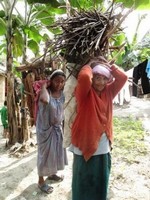First of a three-part series. Part I: Camp Crucible "I was sad to see him back here again," said Matimya, one of more than 100,000 Bhutanese refugees living in United Nations-administered camps in eastern Nepal. "I had hoped I would see him again in Bhutan, but his standing back in our doorway meant we may never get back there," she adds, seated in the corner of the family's dark wattle-and-daub hut in the Beldangi I refugee camp, five kilometers outside the Nepalese town of Damak.
DAMAK, Nepal -- When Matimya Moktan, 41, saw her husband Manbahadur standing unannounced in their doorway after a nine-year absence in prison, her heart sank.
Bhutan’s Radicalized Refugees: Part I

